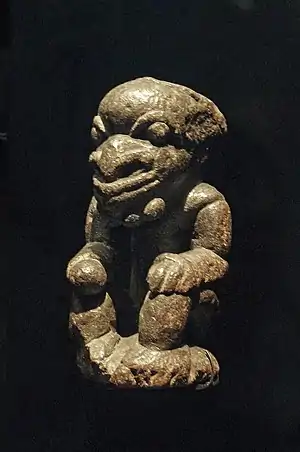Nomoli figurine
A Nomoli (/ˈnoʊmoʊliː/) is a carved stone figurine native to Sierra Leone and Liberia.[1] They are usually made of soapstone, limestone or granite.[1][2]
| Nomoli | |
|---|---|
 A Nomoli figurine. | |
| Year | circa 1500s |
| Medium | Soapstone |
| Dimensions | 17 cm × 10.2 cm (6.7 in × 4.0 in); 9 cm diameter (3.5 in) |
| Weight | 1597 grams |
| Location | Musée du quai Branly – Jacques Chirac, Paris, France |
| Website | www |
Origins
Nomoli figurines are among the earliest works of art from Sierra Leone.[3] The Nomoli figurines and similar stone sculptures are the only known remains of an empire that existed hundreds of years ago in what is Sierra Leone and Liberia today.
Nomoli figurines are often associated with the Mende people as they are often buried on Mende land. They are used as oracles and for protection.[3]
Portuguese explorers recorded the presence of the figurines already in the fifteenth century.[1]
The Mende and Kissi people of Sierra Leone put these small statues near their homes and in fields of crops for protection and increased vegetation, as they believe the Nomoli figurines will give them good health, good harvest, and meals to eat.[3]
During the 20th century, Sierra Leonean immigrants brought their ancestor’s Nomoli figurines with them to the United States as a way to preserve the spiritual powers of the past.
Characteristics and description
Along the coastal region, Nomoli figurines are often carved into a crouching stance with a small object in its hands. Most Nomoli figurines are made out of soapstone, limestone, steatite, and in some cases, granite.
Their heads are oblong shaped. Nomoli figurines buried deeper underground tend to be more well preserved than the ones discovered just beneath the surface of the earth.
References
- "National Museum of African Art". africa.si.edu. Retrieved 2018-06-29.
- "nomoli figure". British Museum. Retrieved 2018-06-29.
- "Figure, Pomdo or Nomoli · Michael C. Carlos Museum Collections Online". carlos.emory.edu. Archived from the original on 2018-06-30. Retrieved 2018-06-29.